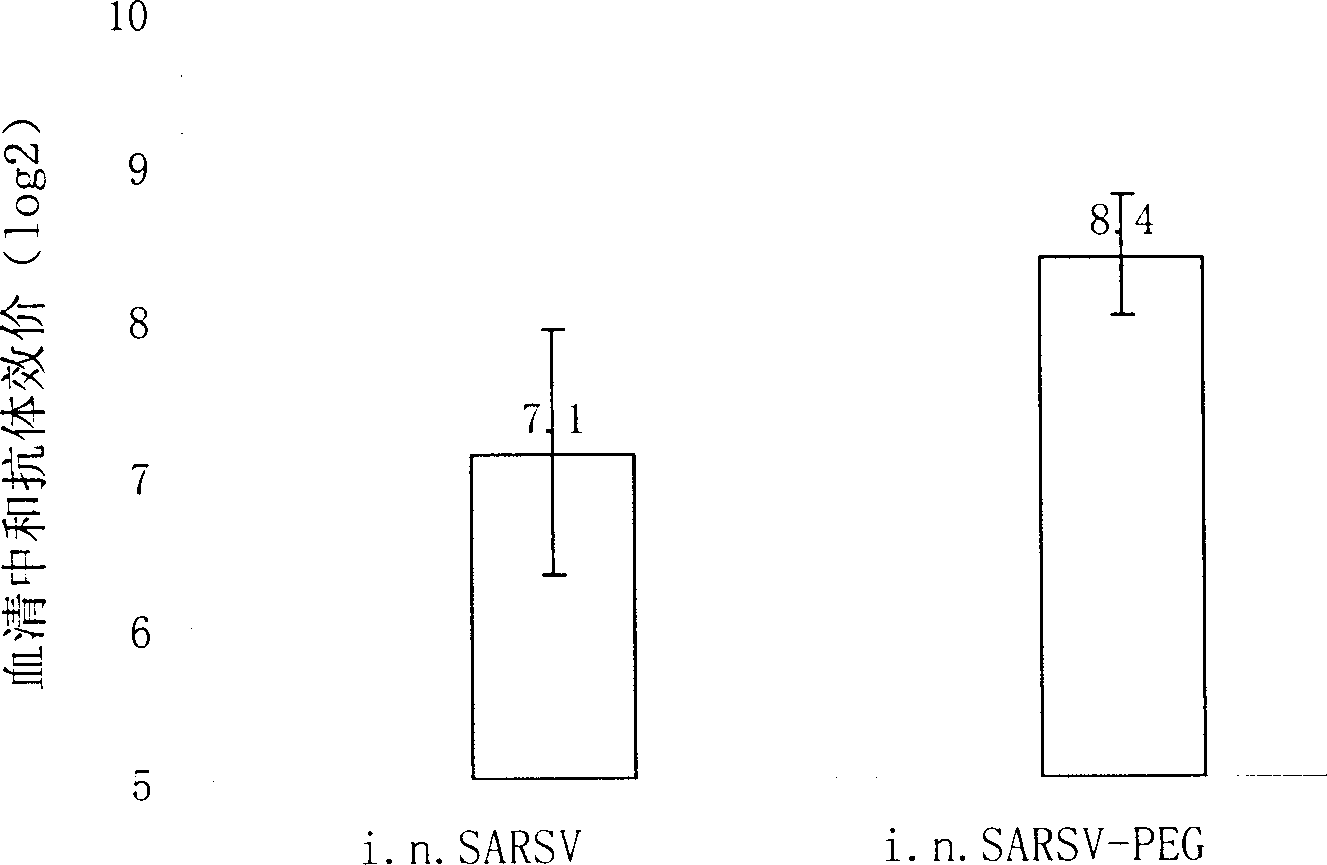Mucous membrane immunizing agent of polyglycol-inactivated vaccine
A technology of polyethylene glycol and mucosal immunity, which is applied in the direction of antiviral agents, antibody medical ingredients, medical preparations containing active ingredients, etc., can solve problems such as adverse reactions, and achieve enhanced immunogenicity and local mucosal immune response , improve the effect of absorption
- Summary
- Abstract
- Description
- Claims
- Application Information
AI Technical Summary
Problems solved by technology
Method used
Image
Examples
Embodiment 1
[0015] Embodiment 1 polyethylene glycol concentrates and inactivates SARS coronavirus
[0016] Pharmaceutical grade polyethylene glycol 6000 was formulated as 35% polyethylene glycol / 1.75M NaCl. Add inactivated SARS coronavirus (CGMCC No.0977) venom at a ratio of 1:5, and incubate at 4°C for 24 hours. Centrifuge at 13,000 rpm for 30 minutes. Remove the supernatant, and the precipitate is dissolved in phosphate buffer (0.01M PBS, pH7.2), and the virus is concentrated to 100 times to obtain the crude inactivated SARS coronavirus mucosal immune preparation.
Embodiment 2
[0017] Example 2 Polyethylene Glycol Concentration, Inactivation and Cracking of Influenza A Virus
[0018] Pharmaceutical grade polyethylene glycol 8000 was formulated as 30% polyethylene glycol / 1.75M NaCl. Add the inactivated lysed influenza A virus solution at a ratio of 1:4, and incubate at 4°C for 24 hours with the H3N3 Panama strain (the domestically produced strain in 2003). Centrifuge at 13,000 rpm for 30 minutes. The supernatant was removed, and the precipitate was dissolved in phosphate buffer (0.01M PBS, pH7.2) to concentrate the virus to 50 times to obtain a crude inactivated avian influenza virus mucosal immune preparation.
Embodiment 3
[0019] Embodiment 3 polyethylene glycol enhances the immunogenicity of nasal drop SARS coronavirus vaccine
[0020] Inactivated SARS coronavirus (G250) vaccine, immunization dose: 50 μg per mouse; PEG-SARS coronavirus inactivated mucosal immune preparation, immunization dose: 20 μg per mouse, immunized Balb / c mice through nasal drops respectively, Vaccines were given every 2 weeks, for a total of 4 immunizations. The mice were sacrificed 2 weeks after the fourth strong immunization, the blood was collected to separate the serum, and the trachea and lungs of the mice were lavaged with phosphate buffer. Serum and tracheal-lung lavage fluid were stored at -70°C until testing. Serum is used to detect the neutralizing antibody of anti-SARS coronavirus; trachea-lung lavage fluid is used to detect anti-SARS coronavirus IgA (indirect immunofluorescence method). The results show that the immunity of PEG-inactivated vaccine nasal drops is significantly higher than that of inactivated ...
PUM
 Login to View More
Login to View More Abstract
Description
Claims
Application Information
 Login to View More
Login to View More - R&D
- Intellectual Property
- Life Sciences
- Materials
- Tech Scout
- Unparalleled Data Quality
- Higher Quality Content
- 60% Fewer Hallucinations
Browse by: Latest US Patents, China's latest patents, Technical Efficacy Thesaurus, Application Domain, Technology Topic, Popular Technical Reports.
© 2025 PatSnap. All rights reserved.Legal|Privacy policy|Modern Slavery Act Transparency Statement|Sitemap|About US| Contact US: help@patsnap.com


